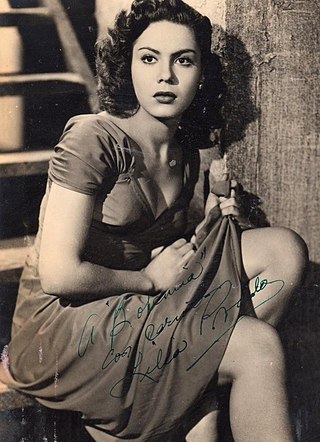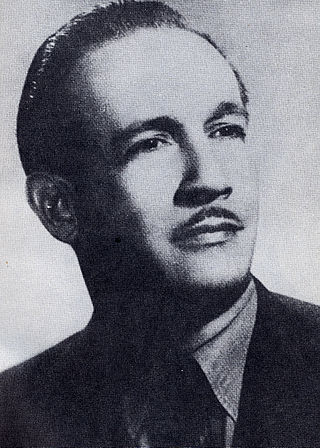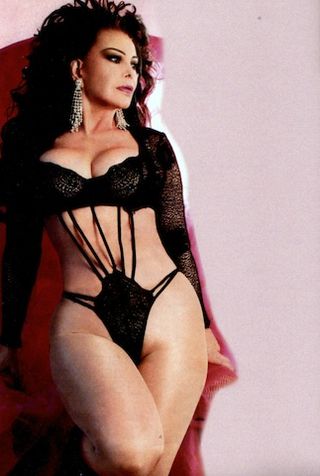Related Research Articles

Yolanda Montes, better known by her stage-name Tongolele, is an American dancer, actress and vedette.
Sasha Montenegro, born Aleksandra Aćimović Popović, was a Mexican actress of Montenegrin descent.

Leticia Lilia Amezcua Prado, known as Lilia Prado, was a Mexican actress and dancer. Noted for her beauty and on-screen sensuality, she was a famous star and sex symbol of the Golden Age of Mexican cinema.

Olga Breeskin Torres is a Mexican violinist, dancer and actress. She was one of the most famous Mexican vedettes in 1970s and 1980s. Since her conversion to Christianity, she has only presented herself as a violinist.

Lilia Guadalupe Mendiola Mayares, better known by her stage name Lyn May, is a Mexican vedette, exotic dancer and actress. She was one of the most popular Mexican vedettes during the 1970s and 1980s, a popular sex symbol, and one of the main stars of Ficheras cinema.

Eliseo Grenet Sánchez was a Cuban pianist and a leading composer/arranger of the day. He composed music for stage shows and films, and some famous Cuban dance music. Eliseo was one of three musical brothers, all composers, the others being Emilio and Ernesto (1908–1981). Emilio went on composing even after having a leg bitten off by a shark in 1930; Ernesto was a drummer who became leader of the Tropicana's orchestra.
La Carabina de Ambrosio is a Mexican television show created and developed by Humberto Navarro, filmed at the Televisa Studios, Chapultepec in Mexico City, from 1978 until 1987. The slogan of the show was "A Magical, Comical, and Musical Variety Show." The show had guest emcees that included César Costa, Gualberto Castro, Fito Girón, and Manolo Muñoz. While the emcees sang a cast member would interrupt rudely and a comedy skit began. The show consisted of numerous skits, jokes and tricks played on the emcees. It is rumored that the reason there were so many emcees during the run of the show was due to the numerous tricks played on them.

Amalia Isabel Rodríguez Carriera, known professionally as Amalia Aguilar, was a Cuban-Mexican dancer, actress and comedian.

Rosa Carmina Riverón Jiménez is a Cuban-Mexican actress and dancer.
The Rumberas film was a film genre that flourished in Mexico's Golden Age of Mexican cinema in the 1940s and 1950s. Its major stars were the so-called rumberas, dancers of Afro-Caribbean musical rhythms. The genre is a film curiosity, one of the most fascinating hybrids of the international cinema.
A vedette is the main female artist of a show derived from cabaret and its subcategories of revue, vaudeville, music hall or burlesque. The purpose of the vedette is to entertain and captivate the public. Vedettes are expected to sing, dance and act on stage. Particularly accomplished artistes are considered super vedettes or first vedettes. Vedettes often appear alongside groups of dancers, flashy and revealing costumes, magicians, comedians, jugglers, or even performing animals. Vedettes specializing in burlesque generally do striptease and may also perform nude on stage.

Mexican sex comedies are films within the comedy film genre of the Mexican cinema industry, though in a class of their own. The storylines typically revolve around themes of sexploitation and "Mexploitation". They are mostly recognized as low-quality films with fairly low budgets. The genre peaked in popularity in the 1970s and 1980s. Although the films had sexually suggestive plots and used numerous comedic innuendos and double entendres, they were not overtly explicit, and were never considered to be pornographic. Furthermore, it was not uncommon for the male characters in these films to comedically fail in their attempts to win over, or have sex with, the female characters. When a man was successful in wooing a woman, the performances were deliberately over-exaggerated and pantomime-like, aiming to generate laughter more than arousal. The genre is similar to, and possibly influenced by, Italian erotic comedies. The popular term "ficheras films" came from the film Las ficheras, produced and released in 1975, which told the stories and experiences of many dancing women who entertained men at nightclubs.

María del Rosario Mendoza Chávez was a Mexican vedette, actress, dancer, and singer. During the 1970s–1980s, she was one of the highest grossing artists in the Mexican sex comedy film genre.
Juana Amanda Seux Ramírez, better known as Wanda Seux, was a Paraguayan-Mexican vedette, dancer, and actress, who enjoyed a long career in film, television, and theatre in Mexico.

Beauties of the Night is a 2016 Mexican documentary film. It is the first production of the filmmaker María José Cuevas. The film shows a glimpse of the glory, sunset and resurgence of five of the main showgirls (vedettes) that triumphed in Mexico in the decades of the 1970s and 1980s.
Thelma Delia Suklenik Snopik, better known by her stage name Thelma Tixou, was a Mexican vedette and actress of Argentine origin. She was one of the most popular Mexican vedettes during the 1970s and 1980s, and she became famous worldwide for her role as The Tattooed Woman in Alejandro Jodorowsky's cult classic film Santa Sangre (1989).
Susan Linda Fair, better known as Princesa Lea is a Canadian-born Mexican vedette, actress, and dancer, of Canadian origin. She was one of the most popular Mexican vedettes during the 1970s and 1980s.
Graciela Prior Marín, better known as Grace Renat, is a Mexican vedette, actress and dancer. She was one of the most popular Mexican vedettes during the 1970s and 1980s.

Gina Romand was a Cuban-Mexican actress. At the time of her death she was one of the last stars from the Golden Age of Mexican cinema.

Angelica Chain is a Mexican actress, model and vedette, who is best known for her acting in fichera films, many of which she participated playing the couple of another famous Mexican actor, Alfonso Zayas. Chain was once considered a sex symbol in Mexico.
References
- ↑ YouTube: Interview with Princesa Yamal and Wanda Seux for the film Beauties of the Night
- ↑ YouTube: La historia detrás del mito, Mexican Vedettes TV Azteca, México
- ↑ El Universal: A Robbery in the Museum
- ↑ "Local.mx: About the film "Beauties of the Night"". Archived from the original on 2017-01-10. Retrieved 2017-01-10.